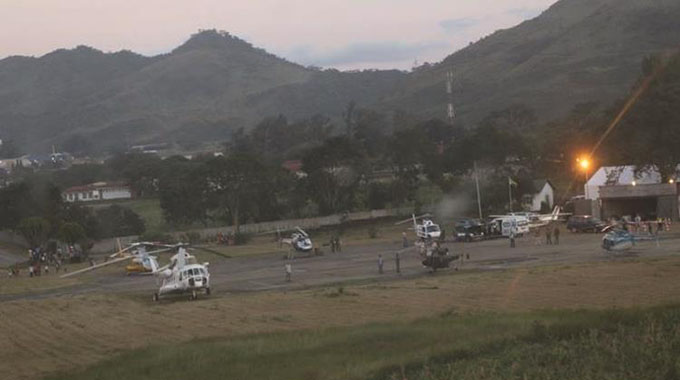AFZ interventions saved lives during, after Idai

Gilbert Pedro Chirembwe and Chaeruka Nathan Pedzisai Correspondents
March 15 and 16, 2019 are days that may never be erased from the minds of the people of Manicaland and all Zimbabweans at large.
Chimanimani and Chipinge districts are still shaking off the effects of a nightmare and tragedy that all Zimbabweans are still failing to fully comprehend.
Though the weather man had earlier warned about the impending danger, the sad truth is no one imagined the extent of damage it would cause.
The tragedy destroyed properties, killed over 340 people and more than 300 went missing. There was also loss of livestock and crops. Infrastructure was destroyed in a way Zimbabwe has never experienced.
The weather continued to be hostile for those first two days and rendered most parts in Chimanimani like Vumba, Muchadziya, Biriri, Ngangu, Hlabiso, Mutsvangwa, and others virtually inaccessible by road.
Rescuing the affected was a mammoth task for the nation.
Dealing with such a phenomenon required extensive use of aircraft, but visibility was a challenge due to the persistent rain and a heavy low cloud that covered the mountainous district.
Narratives of how some of the fortunate ones did make it are still being told with tears.
One thing that comes out from their horrific experiences points out to grace not, bravery. They all acknowledge the power and speed of the water was no match to any mortal.
Those from the outside could only watch or do little because of the violent winds and heavy rainfall in the area.
The mountains quaked and trees could not stop the mighty gushing winds with speeds, mudslides and boulders rolling down mountain slopes.
Survival for those who escaped death became the ultimate thing, with some finding shelter on rooftops, tall trees, boulders and even the mountains.
Help only started coming on the third day.
The Air force of Zimbabwe (AFZ) acted on a distress call by the Civil Protection Unit (CPU) to deploy helicopters to search and rescue victims.
In the early hours of the morning of March 17, 2019, captain of an AB412 Augusta Bell housed at Manyame Air Base, Squadron leader Mpangi together with his core pilot Squadron leader Chirimuuta and five crew on board braved the weather and flew to Chimanimani to rescue victims of Cyclone Idai.
After a fierce journey of constant navigation to break, the captain and his crew finally landed in Chimanimani, where the locals had already sought refuge at Chimanimani Hotel.
On seeing the helicopter, they swarmed it with tears and they requested the crew to find and rescue their loved ones who had gone missing.
The crew really knew the task which had befell them. In the following days, members of the Zimbabwe National Army (ZNA) from 3 Brigade were navigating their way on the ground to rescue the flood victims.
It was not easy as they had to cross destroyed bridges and roads.
Past experiences were quite different. For example, when Cyclone Eline struck in the year 2000, the situation did not reach such dire levels and people simply moved to higher ground and were safe.
Cyclone Idai was a different ball game altogether. Even being on higher ground was no guarantee to safety.
Many were disconnected from family in the wake of running to safety. Coping with a disaster of such magnitude became the toughest task the people of Manicaland had to endure.
They were cut off from the rest of the nation. No communication was possible and electricity grid was also destroyed together with roads and bridges.
Air Commodore Chiganze was deployed to command air assets and platforms provided by AFZ as well as those availed by Econet Wireless, Government and individuals for rescue operations.
A command centre comprising ZDF, other Government departments, corporate world, United Nations (UN), international organisations, churches and individuals was immediately setup at Skyline for the coordination of rescue teams on the ground.
Due to accessibility constraints and limited landing space for the helicopters, the command centre had to be moved to Mutare Aerodrome for the smooth running of the operations.
The command centre set routes and flight schedules to coordinate the whole exercise which had been detailed to cover every affected village and townships in the shortest possible time.
What followed in the coming days was a reflection of a nation being brought together by the disaster that had struck as Government, local companies, non-governmental organisations (NGOs), as well as the international community harnessed resources to help the victims.
The air platforms immediately started making medical drops and provided food, tents, shelter, blankets and solar lamps.
The injured were ferried to Mutambara and Mutare general hospitals.
Doctors were also deployed on the ground to provide vital medical assistance.
Skyline was established as the first rescue centre on the third day of the tragedy.
It was team work as different players provided various inputs like helicopters and air ambulances, foodstuffs, medicines, drinking water, tents, clothes for rescue and relief operations.
The civil helicopters were mainly seized with relief efforts, whilst the AFZ took up search and rescue operations together with the ZNA and the Zimbabwe Republic Police Sub-Aqua Unit. The operations included hot extraction, casualty evacuation and the transportation of recovered dead bodies.
The hyper level of activities exacerbated by the amount of people who required relief aid made smooth coordination of all tasks nearly impossible.
A rear launch centre was set at Mutare Aerodrome to help harmonise operations among all players.
After the hype witnessed in the first two weeks, some players began to pull out, having been satisfied by the contribution they had made when it mattered most.
This did not mean things had returned to their normal. Big players comprising Government, the United Nations World Food Programme and Econet continued to make sure survivors were replenished with food, medicines and other utilities.
AFZ helicopters continued to be fully operational, airlifting food, clothes, medicines to inaccessible areas and transporting the sick to Chipinge and Mutambara hospitals.
The fact that there were still so many people missing meant the helicopters had to maintain their presence, helping relevant ministries to access all inaccessible areas for damage assessment and requisite recovery efforts required.
The extent of damage recorded in townships such as Kopa and Ngangu was alarming as several households reported missing people, while many had died and some washed away to neighbouring Mozambique.
Bridges, roads, power lines connecting and linking routes to these various townships and villages were all destroyed.
Apart from these affected areas, other villages destroyed included Wengezi, Silverstream, Chikukwa, Vimba and Rusitu mission schools to name but a few.
One of the victims of the disaster, Tendai Nyabanga from Ngangu Township, whose house was literally destroyed, thanked the AFZ for ferrying him to Mutambara Hospital to be treated and advised the Government to make efforts to provide accommodation to those severely affected.
Wing Commander Christopher Musembwa, who was the AFZ Liaison Officer noted that: “The whole operation’s success was achieved due to a high level of coordination demonstrated by all players.
“Our pilots were excellent flying in such a mountainous area with very unpredictable weather. When we started the operation, the main thrust was on search and rescue, which presented bigger challenges.
“After the initial hype when things had stabilised a bit, we moved to search and recovery meant to help those who were in dire need to get necessities like food, medical attention and shelter,” he said.
Manicaland Provincial Administrator Mr Edgars Seenza said he was very impressed to work with the AFZ team, confessing that it was his first experience to work with the force on a task of this magnitude.
He hailed their professional conduct in the discharge of their duties.
“Our operations were made effective by the coming in of the AFZ, whose air factor allowed us to quickly be able to access all areas of the two hardest hit districts, Chimanimani and Chipinge.
The establishment of a Forward Distribution Point at Silverstream literally improved how relief operations were conducted. It ensured continuity in terms of vital relief supplies as liaison with relevant local district civil leadership allowed helicopters to offload at correct places and handing over the goods to the relevant people,” he said.
Although Cyclone Idai has been such a disaster, the AFZ has drawn a lot of positives.
The AFZ still remains a people’s force and its personnel continues to showcase high levels of proficiency.
That the entire operation took place without any incident is a clear indication of this fact.
Chimanimani has always been the training area for Mountain Flying for number seven and eight squadrons.
This operation presented a sure test for the pilots and technicians on their capacity to scale the mountains when need arises and this they did with aplomb.









Comments